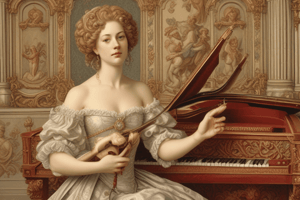Podcast
Questions and Answers
What is the definition of opera?
What is the definition of opera?
- A genre of music that combines jazz and a written dramatic text
- A genre of music that combines symphonic music and a written dramatic text (correct)
- A genre of music that combines rock and roll and a written dramatic text
- A genre of music that combines hip hop and a written dramatic text
Who created the first opera, Dafne?
Who created the first opera, Dafne?
- Wolfgang Amadeus Mozart
- Jacopo Peri (correct)
- Giuseppe Verdi
- Antonio Vivaldi
What are some of the artistic disciplines that opera brings together?
What are some of the artistic disciplines that opera brings together?
- Music, singing, dance, theater (correct)
- Painting, sculpture, literature, architecture
- Psychology, sociology, anthropology, philosophy
- Mathematics, physics, chemistry, biology
Which musical currents have influenced the evolution of opera?
Which musical currents have influenced the evolution of opera?
What was the fast-slow-fast structure introduced by the Roman school of opera?
What was the fast-slow-fast structure introduced by the Roman school of opera?
Who was the main representative of the Neapolitan School?
Who was the main representative of the Neapolitan School?
What is the difference between opera seria and opera buffa?
What is the difference between opera seria and opera buffa?
Who was the first English opera composer of note?
Who was the first English opera composer of note?
What is pasticcio?
What is pasticcio?
Flashcards
What is opera?
What is opera?
A musical genre that combines symphonic music with a dramatic text (libretto) performed by an orchestra and singers.
When and where was the first opera composed?
When and where was the first opera composed?
The first opera, "Dafne", was composed by Jacopo Peri in 1597 in Florence, Italy, marking the beginning of this artistic form.
How does opera reflect its time period?
How does opera reflect its time period?
Opera reflects the societal and cultural currents of its time, incorporating political, philosophical, religious, and aesthetic ideas into its productions.
How has opera evolved through musical periods?
How has opera evolved through musical periods?
Signup and view all the flashcards
What were the characteristics of Baroque opera?
What were the characteristics of Baroque opera?
Signup and view all the flashcards
How did Venice influence opera?
How did Venice influence opera?
Signup and view all the flashcards
What was the Neapolitan school of opera known for?
What was the Neapolitan school of opera known for?
Signup and view all the flashcards
What are the two main types of opera in the 18th century?
What are the two main types of opera in the 18th century?
Signup and view all the flashcards
What is a pasticcio opera?
What is a pasticcio opera?
Signup and view all the flashcards
Study Notes
A Brief History of Opera
- Opera is a musical genre that combines symphonic music, usually performed by an orchestra, and a written dramatic text – expressed in the form of a libretto.
- It is a multidisciplinary genre that brings together music, singing, dance, theater, scenography, performance, costumes, makeup, hairdressing and other artistic disciplines.
- Opera was born in 1597 with the creation of the first opera, Dafne, by Jacopo Peri, in Florence, Italy.
- The subsequent evolution of opera has run parallel to the various musical currents that have followed one another over time: Baroque, Classicism, Romanticism, and avant-garde.
- Opera is a reflection of the various currents of thought, political and philosophical, religious and moral, aesthetic and cultural, peculiar to the society where the plays were produced.
- Opera has its roots in the various forms of sung or musical theater that have been produced throughout history all over the world.
- In Ancient Greece, the theater was one of the favorite spectacles of society, where the main dramatic genres (comedy and tragedy) were born.
- During the Middle Ages, music and theater were also closely related, and they were works of religious character.
- In the Renaissance, several musical-vocal genres emerged, such as the madrigal, the oratorio, the intermedio and the ballet de cour, which paved the way for the birth of opera.
- Opera’s success began among the nobility, and from Florence, it spread to the rest of Italy.
- The House of Gonzaga of Mantua then commissioned the famous madrigal composer Claudio Monteverdi to write an opera: La favola d'Orfeo in 1607, which gave structure to modern opera.
- During the first decades of the 17th century, the opera gradually spread, and religious themes were introduced.
- The Roman school of opera introduced the fast-slow-fast structure, which would be widely used ever since.History of Opera: Baroque and Venetian Opera, French Opera
Baroque music was characterized by contrast, violent chords, moving volumes, exaggerated ornamentation, and varied and contrasted structure.
The Baroque orchestra was small and mainly composed of string instruments, plus some oboes, flutes, bassoons, and trumpets.
Baroque opera was known for its complicated, ornate, and elaborate scenography, with sudden changes and complicated lighting and sensory effects.
Venice was the first place where music was detached from religious or aristocratic protection to be performed in public places, and it became the major opera-producing center.
Bel canto, a vocal technique of difficult execution, emerged in Venice, and the main interpreters were the castrati and the prima donna sopranos.
Claudio Monteverdi, who settled in Venice, composed twelve operas, and his disciple, Pier Francesco Cavalli, introduced some novelties, such as the use of short arias.
In France, the first Italian opera was performed in Paris in 1645, and two years later, Luigi Rossi's Orfeo was performed, which caused a great sensation.
Jean-Baptiste Lully adapted opera to French taste, with choirs, ballets, a richer orchestra, musical interludes, and shorter arias.
Marc-Antoine Charpentier, a composer, and performer of viola da gamba, musicalized some plays by Molière and composed several plays for the Comédie-Française.
After Lully's operas, the opera-ballet, a hybrid genre of opera and ballet, became popular in France, and it was introduced by André Campra.The Development of Opera in Europe
-
Opera spread throughout Europe in the seventeenth century, mainly under Italian influence.
-
Heinrich Schütz was the pioneer of opera in Germany, adapting Rinuccini's Dafne in 1627.
-
Reinhard Keiser was the leading composer of this period in Germany, composing operas entirely in German and directing the Theater am Gänsemarkt.
-
Emperor Leopold I of the Holy Roman Empire encouraged opera in Austria after hearing Cesti's Il pomo d'oro in 1668.
-
In England, the masque was a precedent for opera, and the first English opera was The Siege of Rhodes in 1656, with music by five composers.
-
John Blow was the first opera composer of note in England, followed by Henry Purcell, who composed Dido and Aeneas in 1689.
-
King Ladislaus IV sponsored opera in Poland, and in 1633, La fama reale, the first opera by a Polish author, was premiered.
-
In Spain, the first opera was premiered in 1627 at the Alcázar de Madrid, and Juan Hidalgo was the author of Celos aun del aire matan in 1660.
-
The Neapolitan School introduced a more purist, classicist style of opera in the second half of the 17th century.
-
Alessandro Scarlatti was the main representative of the Neapolitan School, and he introduced numerous novelties, including the three-part aria.
-
Other distinguished representatives of the Neapolitan School were Giovanni Battista Pergolesi, Nicola Porpora, Leonardo Vinci, Leonardo Leo, and Giovanni Bononcini.
-
Late Baroque was the musical production of the first half of the 18th century, and the main center of production remained in Italy, especially Naples and Venice.
-
Ferdinando Galli was an Italian who notably developed scenography during this period.Italian Opera in the 18th Century
-
Opera was divided into two genres: opera seria and opera buffa.
-
Opera seria focused on classical mythology and had a moralistic component.
-
Opera buffa was intended for a more popular audience, influenced by the Commedia dell'arte.
-
Intermezzi were introduced to satisfy the lower-class audience who liked comic characters.
-
The disappearance of comic characters left a void that was filled by operatic intermissions.
-
Giovanni Vincenzo Gravina was a major theorist of serious opera.
-
Apostolo Zeno and Pietro Metastasio were the most relevant librettists of the era.
-
Venice remained one of the main operatic centers, with Antonio Vivaldi as the main representative of the Italian late-baroque school.
-
The Neapolitan school was split between opera seria and opera buffa, with Niccolò Jommelli and Tommaso Traetta as main representatives.
-
Carlo Goldoni was a notable librettist for opera buffa, incorporating elements of the Commedia dell'arte.
-
Niccolò Piccinni and Baldassare Galuppi were notable composers of opera buffa.
-
Pasticcio, an opera composed jointly by several composers, appeared in this period.
Studying That Suits You
Use AI to generate personalized quizzes and flashcards to suit your learning preferences.





